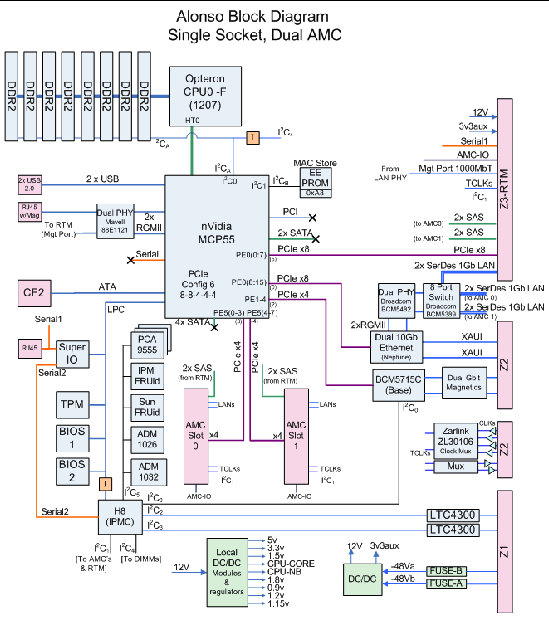| C H A P T E R 5 |
|
Hardware Architecture |
This chapter provides information about the hardware architecture.
This chapter contains the following topics:

AMD Opteron processors with Direct Connect Architecture include several new features, including seamless quad-core upgradability and DDR2 memory. AMD Opteron processors with DDR2 memory feature a common core architecture that is consistent across 1-way, 2-way, and 8-way systems. Features of the second generation 2.2-GHz AMD Opteron include:
The following processors are supported on the Sun Netra CP3220 blade server:
FIGURE 5-2 AMD Opteron Processors Block Diagram

The Sun Netra CP3220 blade server supports 1-Gbyte, 2-Gbyte, and 4-Gbyte registered DDR2-667 memory, for up to 32 Gbytes memory total. When four DIMM slots or less are populated, the DIMM clock rate will be set to the max clock rate of up to 333 Mhz. When six or eight DIMMs slots are populated, the DIMM clock rate will be set to a max clock rate of up to 267 Mhz.
The AMD Opteron’s processor’s memory controller works in 144-bit mode ECC operation. For optimal performance, memory DIMMs must be installed in like pairs. The controller supports 1 bit per byte ECC and supports DDR2 667 registered DRR SDRAM modules. For more information on supported DIMM configurations, see Section 2.3.6.1, DIMM Requirements.
Additional features of the Sun Netra CP3220 blade server’s memory architecture include:
Networking and I/O are provided by the following chips and interconnects:
The nVidia MCP55 media and communication processors (MCP) are based on a high-performance, scalable architecture with a low power design and low footprint optimized for power-constrained rack and blade servers. nVidia’s HyperTransport design integrated tightly with the AMD Opteron Direct Connect architecture to deliver 32-bit and 64-bit performance.
The Sun Netra CP3220 blade server uses one nVidia MCP55 for:
PCI Express 1.0 (PCIe) is a high-speed, point-to-point dual simplex chip interconnect. It is the latest extension of the PCI bus. PCI e operates at 2.5 GHz and supports land widths of x1, x2, x4, x8, x16, and x32. Additional features include:
The Sun Netra CP3220 blade server provides dual 1-Mbyte BIOS chips that support redundant BIOS images for increased reliability. The default chip acts as the primary BIOS chip and automatically selected for update during a firmware upgrade. The secondary BIOS chip retains the original BIOS image, and can be used through manual configuration if the primary BIOS is corrupt.
The Sun Netra CP3220 blade server provides a Trusted Platform Module (TPM) chip, which enables various security features, including hardware and software authentication. This chip is reserved for future use on the Sun Netra CP3220 blade server.
The Broadcom 5715C Gigabit Ethernet chip used on the Sun Netra CP3220 blade server provides two 10/100/1000 MBASE-T interfaces to the Zone 2 connectors. It incorporates the media access control (MAC) and physical (PHY) layer functions for the two LANs used as the ATCA base fabric.
The Sun Netra CP3220 blade server is equipped with one Sun Dual 10-Gbit Ethernet/Quad 1-Gbit RGMII Network Interface chip that is specifically designed to support multicore and multithreaded processor with minimum CPU load while maximizing network I/O thoughput.
Sun 10 GbE Multithreaded Networking ASIC provides two 10-Gbit XAUI Ethernet connections to the ATCA back plane extended fabric, where four lanes are driven at 3.125 Gbyte/sec (if the ATCA switch supports 10-Gbit Ethernet) or a single lane at 1.25 Gbyte/sec if the switch is a 1-Gbit Ethernet device.
Sun 10 GbE Multithreaded Networking ASIC also provides two 1 Gbit RGMII ethernet connections to the Broadcom BCM5482H chip, which converts to SERDES and routes the SERDES signals through and 8 port switch and providing two 1Gb LANS to Zone 3-RTM and to each AMC slot.
The Sun Netra CP3220 blade server contains two AMC slots, B1 and B2, which are available from the front panel. Both slots are single-width, mid-height slots. If needed, AMC I/O connectivity can be accessed from the front panel (depending on the AMC card installed) and through the optional ARTM.
Each slot has one hot-plug connector for the AMC cards. The Sun Netra CP3220 blade server conforms to the PICMG Advanced Mezzanine Card AMC.0 specification R1.0 ECR_002 D0.9, June 29, 2006, and supports AMC.1 Type 4E2 cards, as defined by the same specification.
EIDE is an enhanced IDE controller, implemented through the nVidia MCP55 chip. The Sun Netra CP3220 blade server contains one on-board 50-pin Type II Compact Flash connector, for use with an optional compact flash card. The location of the compact flash connector allows access to this component only when the blade server is removed from the ATCA chassis.
The Sun Netra CP3220 blade server supports AMC cards with SAS/SATA drives under the following conditions:
There is no native support for SAS or SATA drives on the Sun Netra CP3220 blade server.
Copyright © 2009 Sun Microsystems, Inc. All rights reserved.